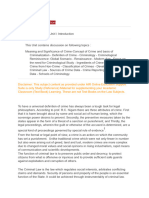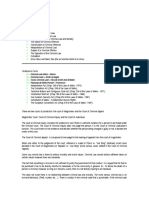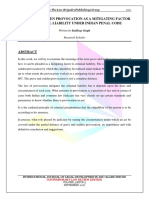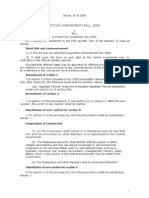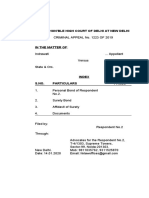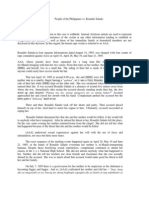ASSIGNMENT
LAW OF TORTS
Submitted By
Kunal Kalita
Semester
SM0121032
Faculty in Charge
Mr. Sahib ChoudharyASSISTANT PROFESSOR OF LAW , NLUJAA NATIONAL LAW UNIVERSITY AND JUDICIAL ACADEMY GUWAHATI, ASSAM9TH NOVEMBER, 2021

HowLawofTortsandLawofCrimesare Converging
Throughout its history, law especially common law has evolved in a commensurate manner.During the early stages of its inception and implementation, a victim could approach thecourt of justice demanding remedy for a particular wrongful act, either on the basis of criminal law or the law of torts. But with the passage of time, both criminal law and tort lawhave been shaped into their own distinct structures incorporating several niche features andcharacteristics. Criminal law in India is primarily encompassed under the Indian Penal Code,1860, Criminal Procedure Code, 1973, Indian Evidence Act, 1872 and a few other speciallaws catering to special situations and circumstances. As per the normative Tort Law is notcodified and has been developed through ‘judicial precedents’. It owes its origins to commonlaw development and is one of the oldest branches of law.The doctrine of common-law crimes is largely defunct.
1
By contrast, tort law remains mainlya set of common-law, judge-made doctrines (although the statutory overlay is increasing).While the aim is to shed light on the Convergence of Torts Law and Criminal law, it isimportant to comprehend the structure and functionality of a tort and a crime in order toestablish the grounds for its convergence.1. Tort claim is a personal action and will be pursued by the injured person whereas thestate persecutes violations of criminal law. The consent of the victim is not necessaryor required for the criminal persecution to be brought.2. The purpose of bringing legal action for tort is to claim compensation in the form of damages whereas in a criminal prosecution, purpose is to punish the offender byimprisoning or fining him/her.
1
Kenneth W. Simons, THE CRIME/TORT DISTINCTION: LEGALDOCTRINE AND NORMATIVE PERSPECTIVES
3. When it comes to a criminal wrong, it becomes paramount to determine the presenceof guilty intention i.e Mens Rea. One of the most important principle of criminal lawis “
ACTUS NON FACIT REUM, NISI MENS SIT REA
” which means that an act (actusreus) does not make a person guilty unless the mind is also guilty (mens rea).However, no such principle is required for an act to amount tort.4. When it coms to Tort, harm needs to be there as a prerequisite to remedy whereasthere is no such requirement for criminal law. Along with the act that has causedharm, criminal law also punishes potentially dangerous acts that have not yet causedharm and acts that are considered by the community to be immoral, even if the actsare not "harmful" in the narrow semantics of the term.5. Tort law does not purport to provide remedies proportional to the injurer's wrong:normally, compensation is the remedy, whatever the nature of the tort or wrong.
2
Thecompensatory remedy is measured according to the intensity of the harm caused, andtherefore is proportional in that manner. Criminal law on the other hand in itsstructural functionality contains a proportionality principle which requires the punishment to fit the severity of the crime. Therefore the punishment doled out is proportional to the culpability of the offender and the seriousness of the crime andharm done or going to be done.6. In comparison to torts, the spectrum of culpability or fault is much more broader incriminal law. The spectrum is stretched along two dimensions: the state of mind, or mens rea, element and the conduct, or social harm, element i.e actus rea. Thus, incriminal law, the required culpable state of mind can range from strict liability tocarelessness to recklessness to knowledge to purpose, with different punishmentsdepending on the mens rea. (Homicide's several degrees and categories are the bestexample of this range.) In addition, the behaviour or social harm component variesgreatly.
3
In the case of tort law, the Intentional torts come in a small number of varieties, while recklessness and strict responsibility come in even fewer. To be sure,there are a variety of torts that deal with different types of conduct and social harm in
3
See generally
D
OUGLAS
H
USAK
, O
VERCRIMINALIZATION
:T
HE
L
IMITS OF THE
C
RIMINAL
L
AW
9-10 (2008) (notingthat at the federal level alone, commentators have estimated that we have 3,300 separate crimes and many moreregulations that are enforceable through criminal sanctions).
2
See
John C.P. Goldberg & Benjamin C. Zipursky,
TortLaw and Moral Luck
, 92 C
ORNELL
L. R
EV
. 1123, 1142-43(2007).
addition to the bodily harm that negligence law protects. The protection of emotionalinjuries, for example, can range from emotional anguish caused by a negligent actor to emotional distress caused by a negligent actor. Emotional injuries are protected in avariety of ways, from emotional distress caused by an actor whose conduct threatened bodily injury, to breaches of privacy, and defamation. Nonetheless, when compared tothe number of separate offences, the number of distinctive tort grounds of action palesin contrast to the number of distinct crimes.7. In criminal law, the minimum fault needed is frequently something along the lines of extreme carelessness or even recklessness, although in tort law, ordinary negligence isusually sufficient. There are some doctrines of strict liability in criminal law, particularly when it comes to the grade of the offence (for example, reasonablemistake is no defence if the amount of illegal drugs the actor possesses or the value of the goods he has stolen) and when it comes to mistake or ignorance of the law, whereeven reasonable mistake or ignorance is normally not a defence.In criminal law,however, strict liability is less common than in tort law. Tort embraces strict liabilitytheories such as culpability for unusually harmful activities, product manufacturingfaults, and wild animal attacks.
4
In addition, tort law imposes strict liability in theform of vicarious liability, which holds employers liable for the tortious activities of their employees. An extension of this issue is that excuses to liability are significantlymore easily acknowledged in criminal law than in tort law. As a result, although theinsane are normally liable for their torts, they are not criminally culpable (thoughagain, this theoretical difference is belied by actual legal practice, since it isextraordinarily difficult for mentally disordered criminal defendants to succeed withan insanity defense). Furthermore, the status of children in criminal and tort lawdiffers: even very young children are frequently accountable for torts, but they are notcriminally culpable.As we have established the various doctrines and characteristics of both the Law of Torts andthe Law of Crimes, the similarities overlapping both these law are not explicit but subtle andintricate. The crux of formulating an intertwining composition between torts law and criminallaw lies in its application as well as interpretation . There are various terms and tenets that
4
R
ESTATEMENT
(T
HIRD
)
OF
T
ORTS
: L
IABILITY FOR
P
HYSICAL

